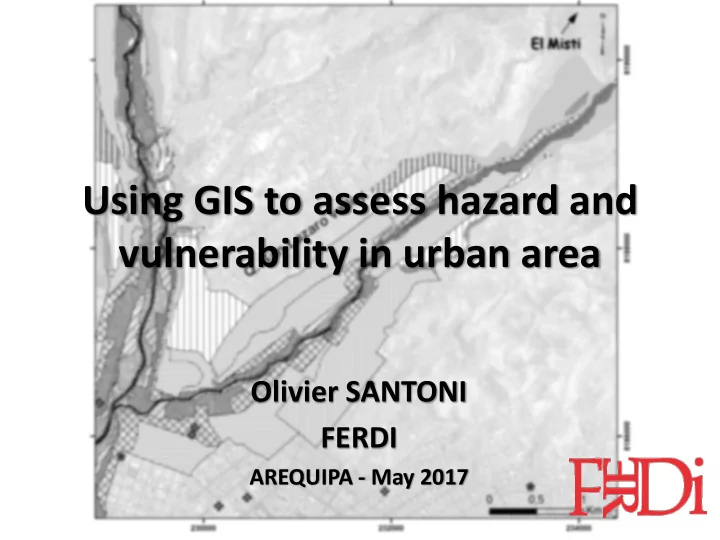

Using GIS to assess hazard and vulnerability in urban area Olivier SANTONI FERDI AREQUIPA - May 2017
Risk assessment • Hazard mapping • Vulnerability mapping at city block scale - Population vulnerability - Physical vulnerability • Complete building inventory using satellite imagery
Determining alluvial terraces Google Earth images analysis Field data
Determining alluvial terraces Google Earth images analysis Field data
Determining alluvial terraces
Determining alluvial terraces 5 flow hazard intensities based on discharge and return period
Socio-economic vulnerability Calculation of weighted distances of every city block to 4 relief infrastructure taking account the road types, presence of bridges and rivers. Road type Criteria Weigh coefficient Type 1 Major roads. 1m = 1 Type 2 Good, large and paved streets. 1m = 1.5 Half paved and half dirt (or Type 3 gravel road). Well graded and 1m = 1.7 maintained. Gravel road or dirt road, Type 4 sometimes with slope. Badly or 1m = 1.9 even not graded. Out of the city, connection with Type 5 1m = 2.1 remote houses. Bridges 1m = 3 Cannot be crossed without Rivers bridges
Socio-economic vulnerability Calculation of weighted distances of every city block to 4 rescue infrastructures taking account the roads types, présences of bridges and rivers.
Isolation index
Isolation index
Residential vulnerability index
Residential vulnerability index
Population vulnerability index Combining isolation index and residential vulnerability index
Population risk level
Population risk intensity
Population risk level
Physical vulnerability Vulnerability of city blocks based on 9 criterias Methods Criteria Parameters Type Elevation of building and number of storeys Building material Type of city block building indice Status or maintenance Type of roof Heterogeneity building size and land use building indice Housing density of the city block density and adjacent housing building indice Based on photo-interpretation Compact shape of the city block shape and regularity building indice Density of street network inside and surrounding city block building indice geographical Type of alluvial terraces elevation above river channel indice geographical Angle of impact situation and angle indice geographical Based on the SPOT-RSE DEM Average slope of the city block slope and location on terrace systm indice geographical Based on a geologic map Bedrock and geotechnical soils indice
Physical vulnerability Five « building » criterias Methods Criteria Parameters Type Elevation of building and number of storeys Building material Type of city block building indice Status or maintenance Type of roof Heterogeneity building size and land use building indice Housing density of the city block density and adjacent housing building indice Based on photo-interpretation Compact shape of the city block shape and regularity building indice Density of street network inside and surrounding city block building indice geographical Type of alluvial terraces elevation above river channel indice geographical Angle of impact situation and angle indice geographical Based on the SPOT-RSE DEM Average slope of the city block slope and location on terrace systm indice geographical Based on a geologic map Bedrock and geotechnical soils indice
Physical vulnerability Four « physical » criterias Methods Criteria Parameters Type Elevation of building and number of storeys Building material Type of city block building indice Status or maintenance Type of roof Heterogeneity building size and land use building indice Housing density of the city block density and adjacent housing building indice Based on photo-interpretation Compact shape of the city block shape and regularity building indice Density of street network inside and surrounding city block building indice geographical Type of alluvial terraces elevation above river channel indice geographical Angle of impact situation and angle indice geographical Based on the SPOT-RSE DEM Average slope of the city block slope and location on terrace systm indice geographical Based on a geologic map Bedrock and geotechnical soils indice
Heterogeneity/homogeneity of city blocks
Heterogeneity/homogeneity of city blocks
Vulnerability map based on building criterias
Exposure map based on physical criterias
Physical vulnerability map based on all criterias
Building survey Access to satellite imagery with high spatial resolution (< 1 m) Pléiades images : 50 cm Free Google images (Google Earth, QGIS) Work at building scale
Building survey Detection of « hidden » buildings in city blocks to complete field survey Image interpretation with field survey observations: 79%
Complete field survey Access to roof type Ex Qda Dahlia
Gracias por su attention
Recommend
More recommend